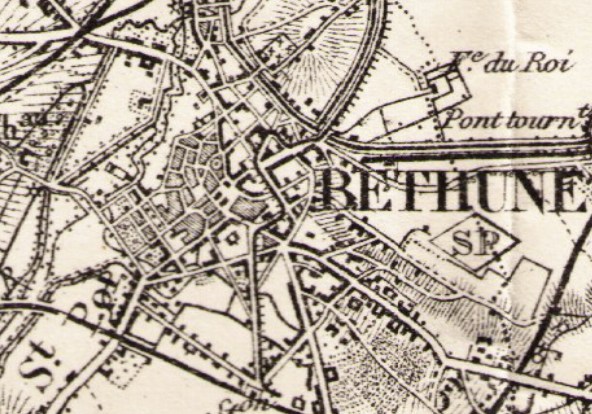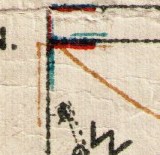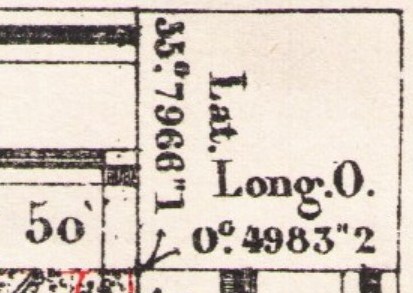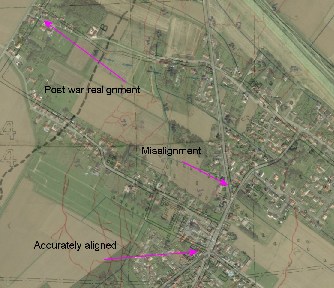Knowledge Centre- Subject Index Main Help page |
Great War maps & GPS:- Expected accuracy
Q. If you obtain a latitude & longitude point for a modern GPS and
apply that to a Great War map, can you be assured that when you visit that
point where Grandpa fought that it is exactly the right place?
A. The right place? Yes. Exactly? Only within limits.
The problems to overcome.
Q. Are all the points shown on the map depicted to the same level of
accuracy?
A. No.
A church spire may well be more accurately placed than a junction in a farm
track. Also see accuracy of maps here.
Ignoring modern map making techniques based on GPS etc., in the Great War
era maps were made using a long and arduous process. The first stage is to
set out a chain of triangulation points to a very high order of accuracy.
In the UK some of these points are still visible as the familiar Trig Points.
These are called 1st order points. From these a larger number of 2nd order
points are triangulated, they are usually visible from a long way off so church
spires, towers and large buildings with flag poles were favoured. From these
teams of surveyors would set out 3rd, 4th and 5th order points giving positions
of points of lesser importance on what then looks more like a map rather than
a set of triangles. Several techniques are useful, even the one used by the
Romans, Plane Table surveying. Once this is complete the line detail is added,
all the complex twists and turns of roads and rivers and positions of more
common buildings. The problem with accuracy is that as points are created
from a higher order point, each time a lower order point is created it cannot
be as accurate as the higher order point, every measurement adds an error.
Great effort is made to minimise these errors but they will always remain,
even on modern maps. The result is that some points on a map are more accurately
placed than others.
In the Report on Survey on the Western
Front 1914-1918, its author Col. Jack said this:-
Accuracy of Maps Dependent on Class of Survey.
The ideal in the map is an accuracy which a scale of 1/20,000 will not conclusively show. 20 metres on the ground is 1 millimetre on this scale; and 1 millimetre is a dimension so small as to be dangerously near the possible error of contraction and expansion of the paper. Let us, however, suppose as a working hypothesis that the position of every topographical feature is known to an assured absolute accuracy of 20 metres, and let us examine fully what this implies.
In the first place we can never be assured of absolute accuracy on any point, no matter how well fixed. But we can speak of accuracy being nearly absolute with reference to some point fixed in the centre of the country-such a point as the Pantheon at Paris, for example.
Now in any general survey there must necessarily be a classification of points into various orders, say, 1st, 2nd , 3rd , 4th and 5th . Suppose the absolute accuracy, as above defined of the 1st order point is 1/1; then that of the second order may be regarded as 1/2; of the third order, 1/4; of the fourth order, 1/8; and of the fifth order, 1/16. Now, though this scale is arbitrary, a geometrical progression such as that given does in practice fairly well indicate the manner in which the accuracy falls off as the order increases. If we regard a 5th order point as any ordinary topographic feature whatsoever, it is a fair assumption that if the absolute error of that point is not to exceed 16 metres, the absolute error of the 1st order point must not exceed 1 metre.
All points in a given area could of course be fixed approximately to the same order of accuracy, even the highest. But in any other than an extremely limited area the highest order could not be maintained without rejecting the elementary principles of economy. Even in countries with the highest development the economical factor necessitates the introduction of the fifth order point, notwithstanding that in subsequent warfare this fifth order point may assume a grave importance. If, however, the assured "absolute" error of this point is to be less than, say, 20 metres, a primary survey of the very highest class is unavoidable.
So an arbitrary point measured using latitude and longitude based on the figures printed on the maps could be as much as 20 metres out of position or it could be within a metre if it was a 1st order point.
See also the page on building a map.
Q. Are maps from 1917 and 1918 more accurate than those from 1915?
A. Yes, often a great deal more accuate
Early in the war some British 1:10,000 maps were redrawn from French &
Belgian 1:80,000 maps. This means that any error on the original map would
then be 8 times greater on the new map, plus the redrawing error.
In 1915 a resurvey was started, the area around Loos was not finished even
in time for the Battle of Loos in September 1915. Other areas on the British
front still had inaccurate maps until much later.
See page Trench Map accuracy comparison

Figure 1. Inaccurate French 1:80,000 map from 1892 used as a source to re-draw British maps.
Q. Why is accuracy important in a Great War map?
A. Artillery.
If a map is required simply to show the respective positions of streets and towns then an ordinary tourist map would suffice but artillery used a technique called "shooting off the map". In this the guns can be in a place hidden from view and hence they could not see their target, a map was set up on a plane (horizontal) table with a compass and the orientation and range to the target taken directly off the map. A 1mm error in a 1:20,000 artillery map would give a 20 metre error at the target in addition to other errors in shooting. The army also required accurate maps to show the logistic situation, whether a road could take one or two way traffic, carry heavy loads, be passable in flood conditions etc. It also required accurate height information so that it could be determined if a point was visible from another point or to take into account height for artillery.
A transcribed Great War document on maps for artillery and artillery boards is available here.
Q. Are trenches shown accurately?
A. Up to a point.
The first problem is that an accurate survey of the enemy trenches was not possible so maps had to be created and updated from aerial photographs. This is based on photogrammetry and other methods which come with their own set of errors.
The second problem was to transcribe the trench lines onto the lithographic plate used to print the maps. Various techniques were used but each contributes an error for every step in the process.
The final error was printing the maps, each colour was produced from a different
pass through the machine and each pass had to be registered with the base
map. Viewing the corners of a trench map can show whether this was achieved,
in quite a few cases it is several mm out of register. As 1mm on a 1:20,000
represented 20 metres on the ground, a 1mm registration error makes the whole
trench line 20 metres out of position.

Figure 2. Map corner showing poor registration of colour runs. This is very common on Great War maps and makes GPS positions of trench lines or other colour printed features far less accurate.
Q. Can the latitude and longitude figures printed on some of the map corners
be used in a GPS?
A. Not without changing GPS settings, even if available
It comes as surprise to many that a single point on earth can have dozens of different latitude and longitude values, it all depends on where the point is measured from, i.e. the datum or more correctly, the CRS, the Geodetic Reference System. Most people will assume that the Greenwich Observatory is zero degrees of longitude but that is not always the case. Some older maps are based on the Pantheon in Paris or the Observatory in Brussels so latitude and longitude values need to be converted. This conversion is not a trivial problem and is itself prone to error. Part of the problem comes from the use of a different "Figure of the Earth", i.e. the values for the size of the earth, there are many to choose from and different countries used different values. An additional problem is that sometimes the particular Figure of the Earth used was not published, it must be inferred. This means that some calculated GPS positions are not very accurate.
GPS by default uses a datum (called WGS84) that does not accurately align
with the Greenwich meridian. If you go to Greenwich you will find you need
to stand about 109 metres East of the Greenwich meridian to make your GPS
longitude read zero. In the extreme case, even WGS84 coordinates will lose
their accuracy owing to plate tectonic movements so WGS84 is updated periodically
to take this into account, new position values will be "accurate"
when they are made but older values will become less accurate in time. To
avoid the need to continually update position values, a datum for Europe (or
rather the European tectonic plate) was defined using 1989 as the original
date and is called ETRS89, The European Terrestrial Reference Frame. In 1989,
WGS84 and ETRS89 points were identical. Truly accurate positions in Europe
are therefore given as ETRS89 values. However, for an everyday use such as
finding points on a trench map, ETRS89 and WGS84 can be considered to be the
same.

Figure 3. Latitude and Longitude shown at Great War map corner, here as Grades not degrees.
The trench map reference converter on this site uses very sophisticated mathematics to convert to WGS84 coordinates. See the converter on the main page.
Q. The British Army maps were based on yards, does this cause a problem?
A. Yes.
When the war started the best maps available were from Belgium, the British surveyors were not aware of the excellent French Plan Directeur 1:20,000 series maps or used them very little. To create a grid covering both France and Belgium, the Belgian maps were set out on a large floor all joined together and the sheet lines extended into France, hence the added letter in some sheets, sheet 51A in France to the West of sheet 51 in Belgium etc. A problem arose from a misunderstanding, the map makers assumed the artillery had to use yard based tables so they superimposed a yard based grid on the metre based Belgian sheet lines. That means that at sheet boundaries the yard based grid and metre based sheet lines do not match. See page on the history of British mapping and how to read read a trench map.
Q. If all of the above were to be resolved and an accurate GPS point established,
can that be used to stand where Grandpa stood?
A. Sometimes.
Whilst modern surveyor grade GPS receivers can give an accuracy measured in cm, phones with GPS and handheld consumer grade receivers give an accuracy of approximately 5 metres, "most of the time". On one particular occasion a GPS may be "spot on", on another it can be 20 metres out. If it uses the Galileo satellite constellation, errors as high as a kilometre can creep in because that constellation is not yet fully operational.
The problem is that a user may assume the unit is "accurate" or worse, that the accuracy is constant. It is not, very far from it. Measures of GPS accuracy are statistical, i.e. described by probability. According to the US Government, "GPS-enabled smartphones are typically accurate to within a 4.9 m (16 ft.) radius under open sky" and FAA approved single frequency GPS SPS receivers can achieve <= 1.891 metre (6.2 feet) accuracy 95% of the the time. This always gets worse if not under an open sky. Buildings, trees, especially those with wet foliage, disrupt or attenuate GPS signals, reducing accuracy as does the satellite signal bouncing off surfaces causing a Multipath error. The apparent accuracy of a car Satnav is misleading, it uses a technique that detects the car is travelling along a particular road and then it shifts the position to centre the indictaed position on that road. In absolute terms, they are as accurate as any other consumer grade GPS.
Q. Can a calculated point be improved?
A. Yes.
The Report on Survey on the Western Front 1914-1918 by Col. Jack gave the relative accuracy of a map as better than a third of the absolute accuracy, so within about 6 metres. To get this into a GPS, a small map fragment is positioned on a modern map and moved to make it fit. It will be noticed that it fits where it touches, some (1st and 2nd order) points will fit very well, others such as small roads and tracks may appear quite in error for reasons stated above. The absolute accuracy of a Great War map is usually no better than +/- 20 yards, this means the defined latitude and longitude of a point is often not quite where it should be. Relative error is far more important to an artillery unit as their exact latitude and longitude is generally of no interest, only the relative distance and bearing from where they are to the target, so a relative error of 6 metres can be accommodated. See also the page on building a map, there the "fits where it touches" problem can be seen to be built into the process of making the map, road junctions being placed more accurately than curves in a road or river etc.
Figure 4. Map showing alignment and misalignment.
Q. Are all reported Great War map references accurate?
A. That depends on a number of factors.
1. Did the soldier have adequate fixed points from which to take bearings? If serving in the artillery, they had access to accurately surveyed pickets used for gun-laying so the reported grid reference is probably quite good. If he was in the middle of a crater field such fixed points are harder to find. A soldier not wishing to be the victim of a sniper may have rushed the plotting of a point as seeing the often far reference points would be more difficult.
2. A grid reference where the Easting and Northing values are single digits are only resolvable to 50 yards, i.e. the grid reference gives the point at the South Western corner of a 50x50 yard square. If the Easting and Northing values are 2 digits each, this changes to a 5x5 yard square. Could the solider at the time have determined his point within such a small square? Imagine he was somewhere in the Hooge crater field, an area with almost no hills and where the prominent features such as church spires had been destroyed. How would he have been able to take two or more compass bearings to find where he was? In such circumstances it is likely he used an estimated position relative to another position, reducing the accuracy desirable for a modern visitor armed with a GPS.
Conclusions
Q. If you obtain a latitude & longitude point for a modern GPS and apply that to a Great War map, can you be assured that when you visit that point where Grandpa fought that it is exactly the right place?
A. The right place? Yes. Exactly? Only within limits.
Those limits could be as great at 50 metres or as little as 1 metre. If precision
is required, a GPS point should be correlated with other means, e.g.
- Accurate compass bearings on the ground taken from fixed points. This was often the means by which a soldier in the Great War would have fixed their position and hence generated the grid reference of interest.
- Use a "transit" as in the practice of inshore sailors. This entails lining up fixed points to establish a line on the ground.
- Use of the position relative to other fixed points on the ground.
If that is done then an intelligent calculation can be made on their relative merits.
A GPS is extremely useful, if used intelligently and with some circumspection.
Knowledge Version 2 1.1
